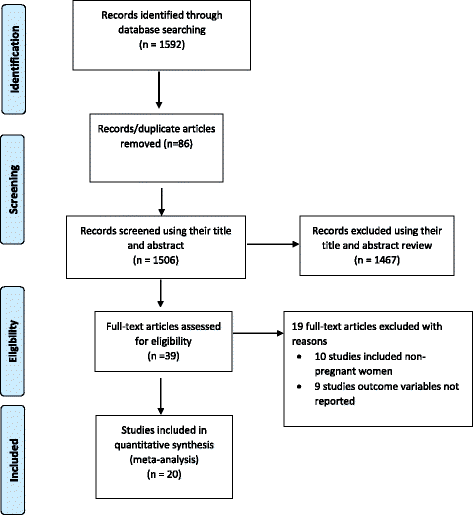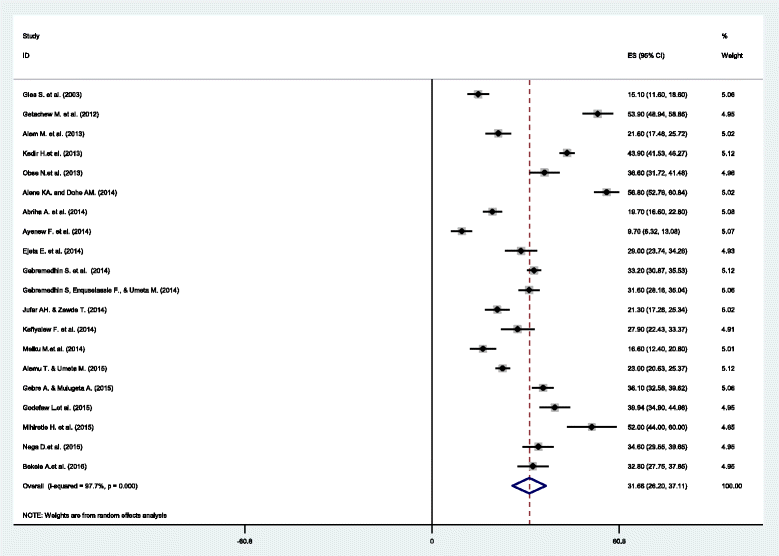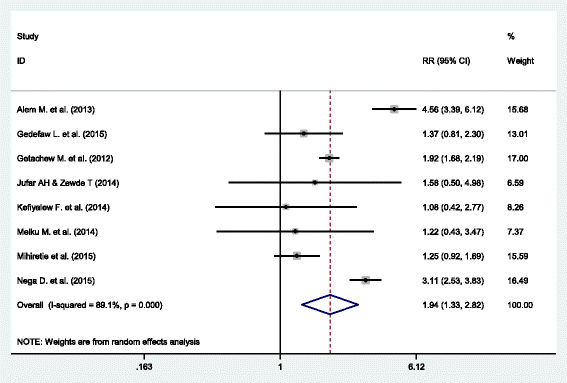Prevalence and determinants of anemia among pregnant women in Ethiopia; a systematic review and meta-analysis
- PMID: 29075500
- PMCID: PMC5646153
- DOI: 10.1186/s12878-017-0090-z
Prevalence and determinants of anemia among pregnant women in Ethiopia; a systematic review and meta-analysis
Abstract
Background: Anemia during pregnancy is one of the most common indirect obstetric cause of maternal mortality in developing countries. It is responsible for poor maternal and fetal outcomes. A limited number of studies were conducted on anemia during pregnancy in Ethiopia, and they present inconsistent findings. Therefore, this review was undertaken to summarize the findings conducted in several parts of the country and present the national level of anemia among pregnant women in Ethiopia.
Methods: Preferred Reporting Items for Systematic Reviews and Meta-Analyses (PRISMA) guideline was followed for this systematic review and meta-analysis. The databases used were; PUBMED, Cochrane Library, Google Scholar, CINAHL, and African Journals Online. Search terms used were; anemia, pregnancy related anemia and Ethiopia. Joanna Briggs Institute Meta-Analysis of Statistics Assessment and Review Instrument (JBI-MAStARI) was used for critical appraisal of studies. The meta-analysis was conducted using STATA 14 software. The pooled Meta logistic regression was computed to present the pooled prevalence and relative risks (RRs) of the determinate factors with 95% confidence interval (CI).
Results: Twenty studies were included in the meta-analysis with a total of 10, 281 pregnant women. The pooled prevalence of anemia among pregnant women in Ethiopia was 31.66% (95% CI (26.20, 37.11)). Based on the pooled prevalence of the subgroup analysis result, the lowest prevalence of anemia among pregnant women was observed in Amhara region, 15.89% (95% CI (8.82, 22.96)) and the highest prevalence was in Somali region, 56.80% (95% CI (52.76, 60.84)). Primigravid (RR: 0.61 (95% CI: 0.53, 0.71)) and urban women (RR: 0.73 (95% CI: 0.60, 0.88)) were less likely to develop anemia. On the other hand, mothers with short pregnancy interval (RR: 2.14 (95% CI: 1.67, 2.74)) and malaria infection during pregnancy (RR: 1.94 (95% CI: 1.33, 2.82)) had higher risk to develop anemia.
Conclusions: Almost one-third of pregnant women in Ethiopia were anemic. Statistically significant association was observed between anemia during pregnancy and residence, gravidity, pregnancy interval, and malaria infection during pregnancy. Regions with higher anemia prevalence among pregnant women should be given due emphasis. The concerned body should intervene on the identified factors to reduce the high prevalence of anemia among pregnant women.
Keywords: Anemia during pregnancy; Ethiopia; Malaria during pregnancy; Meta-analysis; Prevalence of anemia; Short birth interval; Systematic review.
Conflict of interest statement
Ethics approval and consent to participate
Not applicable.
Consent for publication
Not applicable.
Competing interest
The authors declare that they have no competing interest.
Publisher’s Note
Springer Nature remains neutral with regard to jurisdictional claims in published maps and institutional affiliations.
Figures
References
-
- WHO . The global prevalence of anaemia in 2011. Geneva: World Health Organization; 2015.
-
- Black RE, Allen LH, Bhutta ZA, Caulfield LE, De Onis M, Ezzati M, Mathers C, Rivera J, Maternal and child undernutrition study group. Maternal and child undernutrition: global and regional exposures and health consequences. The lancet. 2008;371(9608):243–60. - PubMed
-
- Stevens GA, Finucane MM, De-Regil LM, Paciorek CJ, Flaxman SR, Branca F, et al. Global, regional, and national trends in haemoglobin concentration and prevalence of total and severe anaemia in children and pregnant and non-pregnant women for 1995–2011: a systematic analysis of population-representative data. Lancet Glob Health. 2013;1(1):e16–e25. doi: 10.1016/S2214-109X(13)70001-9. - DOI - PMC - PubMed
-
- Huch R. Anemia in pregnancy. Praxis. 1999;88(5):157–163. - PubMed
-
- WHO . Global nutrition targets 2025: anaemia policy brief (WHO/NMH/NHD/14.4) Geneva: World Health Organization; 2014.
LinkOut - more resources
Full Text Sources
Other Literature Sources




